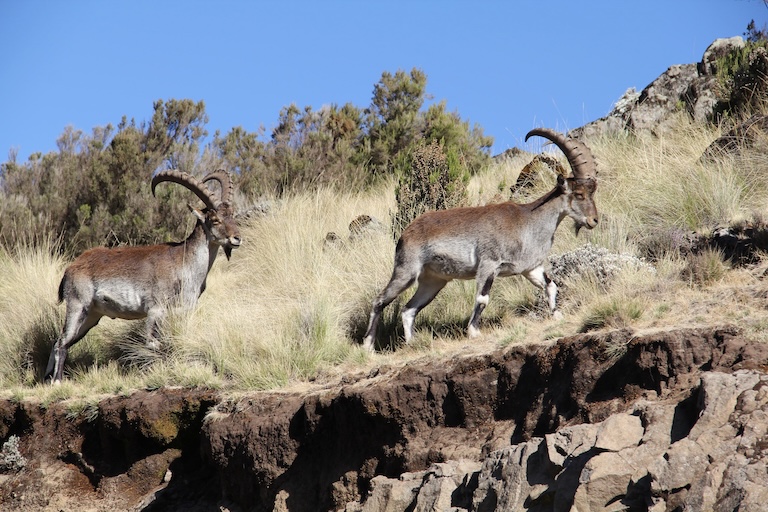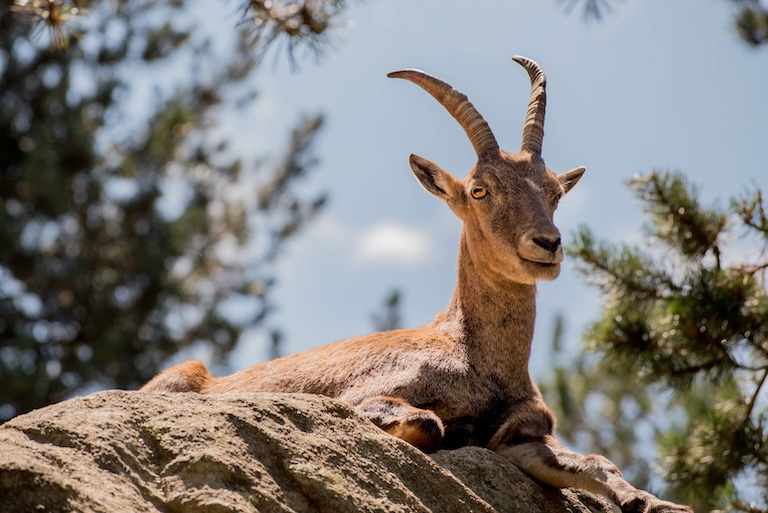Pyrenean Ibex Profile
Extinction is a necessary part of evolution. Mutations occur; some work, and many don’t. The vast majority of organisms we see among us today represent a tiny minority of those that have come and gone – home to the successful mutations that have occurred incrementally for billions of years.
For each success, countless failures are never recorded. And at least one lineage is so bad at surviving, they manage to go extinct twice. But was this a necessary extinction, or yet another man-made catastrophe? The Pyrenean Ibex teaches us valuable lessons about extinction, genetics, and reintroductions.

Pyrenean Ibex Facts Overview
| Habitat: | Rocky, mountainous scrubland, 1200 to 2200 meters |
| Location: | Western Europe |
| Lifespan: | 16 years |
| Size: | Around 1.4m (4.6ft) long |
| Weight: | Up to 80kg (176lb) |
| Colour: | Grey-brown |
| Diet: | Grasses |
| Predators: | Humans |
| Top Speed: | Unknown |
| No. of Species: | 1 |
| Conservation Status: | Extinct |
The Pyrenean Ibex, or Bucardo was one of four subspecies of the Iberian Ibex, only two of which remain today. These great mountain goats were once prevalent across Western Europe, and are present in various historical artworks and trophy collections from the region.
After the ice sheet in Europe retreated and the climate warmed, subpopulations of Iberian Ibex retreated to mountainous regions, ultimately isolating themselves and reducing their genetic diversity. With increased human presence, overhunting rapidly eliminated an already vulnerable subspecies.
But this process and the subsequent attempts to revive the animal from extinction have brought with them a lot of lessons about protection, the importance of genetics, and the expensive nature of a reactive approach to conservation.
Interesting Pyrenean Ibex Facts
1. They evolved with human societies
Ibex are found in cave paintings dating back 30,000 years ago.
These are one of the iconic large mammals to share their space with humans long before agriculture reached the continent and would have had a very practical role in feeding families, as well as a ceremonial and spiritual role by way of the status their glamorous headgear implies.
There were once several species in Europe, and this one, the Pyrenean Ibex, is but one subspecies that migrated into the mountains of Iberia and Southern France around 18,000 years ago, isolating itself as the climate began to warm again.
This was an abundant subspecies as late as the 14th century, but by the 1800s, they were almost wiped out. 1

2. They were already rare when they were recorded
The first official recorded note of this particular subspecies comes from 1767, by which time they were not such a common sight.
Common records show that in the Middle Ages, these goats roamed around the mountains in abundance, and were well-known to locals. But in the 1800s, competition for livestock grazing, as well as an explosion of trophy hunting, led to steep declines, and by 1910 there were only 40 left. 2
3. They likely suffered from disease
While human impacts certainly brought a significant decline upon the subspecies, the low genetic diversity would likely have predisposed the populations to diseases such as scabies and the bluetongue virus.
These elements combined, and even the band on their killing in 1913 and a 1918 conservation project wasn’t enough to keep the species alive.
4. They went extinct just a few years ago
The expansion of animal agriculture led to farmers exterminating the Ibex as competition for grazing resources for their livestock. Further, overgrazing reduced the remaining animals’ food supply.
In the first week of the year 2000, the last individual was found in a Spanish National Park, killed by a fallen tree. There are still debates about the main factor affecting their extinction, though most revolve around avoidable human impacts.
5. They briefly came back
This animal was the first ever to be resurrected by genetic cloning experiments. Though, this is a pretty loose definition, as the subject of the experiment died within moments of being born.
Celia, the last ibex, was housed in a protective park, and well known to researchers. She’s been caught the year before her death, and conservationists were able to take skin biopsies and preserve them.
In the same year of her death, one company was granted permission to try and clone her from these samples, and this became the first such experiment in de-extinction.
Relative to other extinct animals, this particular subspecies had particularly close extant relatives, and its physiology was well understood. This was therefore thought to be a much simpler task than it would be for most other lost mammals.
The plan was to return the cloned Ibex to its original habitat.
After countless failed embryo transfers, eventually, a Pyrenean Ibex was born, and for seven minutes, it became the only living example of a resurrected animal, before the subspecies went extinct for a second time.
6. This could be extremely useful for saving currently endangered species
One of the major contributors to the failure of the subspecies was the lack of genetic diversity present in the remaining Pyrenean Ibex populations around the time of its rapid decline and extinction.
Having been more isolated by the changing climate after the ice age, these populations retreated to higher elevations and were more fragmented than they would have been previously. Smaller, more fragmented populations lead to inbreeding within groups, reducing the genetic diversity and weakening the chances of survival of the group.
Inbred populations are often less reproductively viable, resulting in longer reproductive cycles overall, further increasing their vulnerability to external factors such as hunting by way of increasing their recovery times.
This is a very common problem in extant species on the cusp of extinction. Tigers, for example, are suffering a lot from reduced genetic diversity, and the lessons from the Pyrenean Ibex should help with conservation efforts in this regard.
7. De-extinction should be a last-ditch attempt at conservation
Trying to de-extinct an animal is a bit like bailing water out of a sinking ship with a cup. It could work in theory, but it’s hugely impractical and it would make a lot more sense to patch the holes before setting sail in the first place.
Of course, being proactive isn’t really in our nature, and it takes the power of culture and society to overcome our basic urges and work toward something more efficient and collaborative as a species.
So, while this push to de-extinct everything is exciting and perhaps even necessary, we should be creating a culture that’s aware of and interested in reversing the alarming rate of extinction that’s ongoing around us.
More than a quarter of species left on Earth are now legitimately facing extinction, and it will be a lot easier for us to patch some of these holes now than to bail them out after the fact with expensive and unreliable genetic experiments (not to mention, reintroduction or a resurrected species will still require us to restore its habitat anyway).
So, let’s do that. Habitat destruction and competition with livestock are still threatening our native species, and a shift from animal agriculture towards plant-based alternatives could reduce this effect by 80%.
This is no longer a matter of choice: for those of us who want to see extinctions curbed, it has become a necessity.
For animals like the Pyrenean Ibex to be reintroduced, we need somewhere to put them, and with animal agriculture taking up 80% of our farmland (yet providing 18% of our calories), there simply isn’t space. Meanwhile, our diets are one of the few major contributors to climate change and biodiversity loss that we have complete control over.
The ethical choice is right in front of us, the environment simply requires us to make it. 3

Pyrenean Ibex Fact-File Summary
Scientific Classification
| Kingdom: | Animalia |
| Phylum: | Chordata |
| Class: | Mammalia |
| Order: | Artyodactyla |
| Family: | Bovidae |
| Genus: | Capra |
| Species: | pyrenaica |
| Subspecies: | lusitanica |
Fact Sources & References
- “The Cave Art Paintings of the Niaux Cave”, Bradshaw Foundation.
- “Extinctions and Endings: Celia the Ibex and Lonesome George the Tortoise”, Manifold.
- Damian Carrington (2021), “Plant-based diets crucial to saving global wildlife”, The Guardian.
